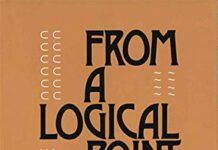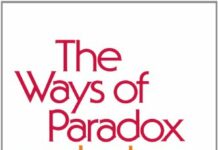
Ebook Info
- Published: 2013
- Number of pages: 309 pages
- Format: PDF
- File Size: 1.75 MB
- Authors: Willard Van Orman Quine
Description
A new edition of Quine’s most important work.Willard Van Orman Quine begins this influential work by declaring, “Language is a social art. In acquiring it we have to depend entirely on intersubjectively available cues as to what to say and when.” As Patricia Smith Churchland notes in her foreword to this new edition, with Word and Object Quine challenged the tradition of conceptual analysis as a way of advancing knowledge. The book signaled twentieth-century philosophy’s turn away from metaphysics and what Churchland calls the “phony precision” of conceptual analysis.In the course of his discussion of meaning and the linguistic mechanisms of objective reference, Quine considers the indeterminacy of translation, brings to light the anomalies and conflicts implicit in our language’s referential apparatus, clarifies semantic problems connected with the imputation of existence, and marshals reasons for admitting or repudiating each of various categories of supposed objects. In addition to Churchland’s foreword, this edition offers a new preface by Quine’s student and colleague Dagfinn Follesdal that describes the never-realized plans for a second edition of Word and Object, in which Quine would offer a more unified treatment of the public nature of meaning, modalities, and propositional attitudes.
User’s Reviews
Reviews from Amazon users which were colected at the time this book was published on the website:
⭐Very dense and a difficult read. Not much for clear explanation on logic. Meaning in Language by Alan Cruise is a much better refresher.
⭐”Whistling in the dark is not the method of true philosophy” – Quine, *Word and Object*Willard van Orman Quine’s 1960 work *Word and Object* is one of the most famous documents of American philosophy. Quine, an Ohio native who studied with Carnap in Vienna and taught mathematical logic and philosophy at Harvard for a half-century, was legendary for being a controversialist who attacked the “analytic-synthetic” distinction and many other philosophical commonplaces; he is also a fine stylist of American prose, one so inimitable as to even discourage quotations. Although he wrote scores of papers and many monograph-length books, *Word and Object* is by far his most noted effort, containing famous remarks on the “indeterminacy of translation” philosophy grad students still joust at today.However famous it and its constituent parts are, I think the general thrust of the book is not well understood, particularly now that it is old enough to be available in a 50th anniversary edition; I am tempted to describe it as a “Jamesian essay on the Tarskian theory of truth”, a book which is both “mannered” and searching, even or perhaps especially compared to Quine’s programmatic essays. This 250-page book has seven chapters, some of which have attracted more attention than others over the years: I will offer brief remarks on each. [As regards this new edition, I am pleased to see that MIT Press has retained some of the features that made the original edition an *objet d’art* but I feel that both Patricia Churchland’s Foreword and Dagfinn Føllesdal’s Preface are disrespectful to the book, which is written in a compass wider than its immediate reception or the vicissitudes of Quine’s decline in advanced old age.]1. “Language and Truth”The book begins with a discussion of the merest “direction towards the world”, in terms of Quine’s famous “holism” about what we do and do not know: although he was always quite explicit about a non-dogmatic empiricism where knowledge of the world begins at “retinal impressions” and suchlike, many people unfamiliar with the “Quine-Duhem thesis” would not understand the idea–often couched in the form of the metaphorical parable from Neurath which begins *Word and Object*–that no particular part of our knowledge of the world is immune to revision, even seemingly “self-evident truths” far from the madding crowd of observed physical objects. This chapter tries to justify a basic “objectivism” about reality, a highly sublimated concordance with Tarski’s version of the correspondence theory of truth, while avoiding the snares then recently set for “realists” by Wittgenstein in the *Philosophical Investigations*.2. “Translation and Meaning””Translation and Meaning” is the absolutely famous chapter of *Word and Object*, one whose quips still amuse young philosophers and which in the ’60s and ’70s generated a great deal of discussion about “radical translation” (and then, in the hands of Quine’s students Davidson and David Lewis, about the slightly different concept of “radical interpretation”). According to Quine, the only slightly fanciful thought-experiment of a field anthropologist trying to learn a wholly foreign language brings home the point that theory is always underdetermined by the facts: when we hear a “native” exclaim “Gavagai” at the sight of a rabbit, we ultimately have no idea what about the appearing of the rabbit they are remarking upon (for all we know, they have a great enthusiasm for “undetached rabbit parts”).3. “The Ontogenesis of Reference”This is the least-well-known of the chapters of the book, and one whose background is not guaranteed to make sense to the contemporary reader: that is to say, Quine’s discussion of the topic of reference (in the sense of the “denotation” of a term) is an implicit critique of the then-newly published theory of P.F. Strawson in his *Individuals*. Strawson believed in a “descriptive metaphysics” which justified a theoretical conservatism about physical objects and persons as ground-floor elements of our “conceptual scheme”; Quine was also cognizant of the reality of physical objects and persons, but he wanted to tell a sophisticated behavioristic story about the usefulness of singular terms (using “divided reference”) and predicates.4. “Vagaries of Reference”Following Timothy Williamson’s book on the topic, “vagueness” became a major topic of research in recent philosophy; Quine–who is honored by contemporary metaphysicians as “one of their own” though it is not exactly clear to me why–was there first, and other parts of referential discourse where “things fall apart” (like “referentially opaque” statements of belief and intention, in which different descriptions of the object of the “propositional attitude” cannot be substituted for each other) are addressed.5. “Regimentation”Modern logic *is* quantificational logic: it did not exist before Frege’s introduction of the quantifiers in his 1879 *Begriffsschrift*, and that is because the scope and power of multiply quantified statements was finally enough to formalize nearly all of mathematical reasoning. Not every linguistic phenomenon yields as easily to axiomatization as “ring theory”, though, and in this chapter Quine spends a great deal of time on “indexicality” (statements tied to particular times and places) and “vacuous terms” like Pegasus, things we can “talk about” even if they have never existed. (Following the work of Kripke and Kaplan at the beginning of the ’70s discussion of these topics took a definitive turn away from Quine’s views, and this is the least relevant of the chapters.)6. “Flight from Intension”Quine, early and late, was an enemy of “modal logic”–the study of necessity and possibility as precisely codified in “operators” usually rendered as a diamond and a box–and here he marshals all his criticisms of the new-fangled reasoning; finally, at the end of the chapter he moves from “intensional” to “intentional” issues, this being the idiom for discussing conscious mental states introduced into modern philosophy by Franz Brentano, and claims (in a move which proved fateful for the “eliminative materialists” about the mind) that statements of belief and desire can in no way be coherently systematized in any “psychology”.7. “Ontic Decision”The final chapter picks up the issues of “theory choice” which began the book, now with a full armamentarium of metalinguistic analysis to turn upon them. Quine’s essential attitude to the question of “abstract objects” like numbers was one of pragmatism: those that caused scientific theory to better cohere better be included as acceptable “posits”, those like “sakes” that mattered not at all ought to be “deprecated”. The book closes with Quine’s famous criticism-homage to Carnap’s strategy of semantic ascent, and the final paragraph begins thusly: “The philosopher’s task differs from the others’, then, in detail; but in no such drastic way as those suppose who imagine for the philosopher a vantage point outside the conceptual scheme that he takes in charge. There is no such cosmic exile.”
⭐This book is Quine’s first full-length book, and it sets forth his most elaborate statement of his wholistic thesis of language. Instead of the metaphorical statement in “Two Dogmas” written a decade earlier, here in Word and Object Quine expresses his thesis in the literal vocabulary of behavioristic psychology with his idea of “stimulus meaning”.Much of the book is an exposition of his thesis of semantic indeterminacy as it is manifested in translation between languages, which thus appears as his indeterminacy of translation thesis sometimes called his “radical translation” thesis. In fact there is nothing radical about it; linguists have long known of such translation problems. As has long been said: traduttore,traditore. But Quine uses it to critique positivism, and it is essential to his pragmatism.In the translation situation he portrays the field linguist in the same situation that the positivist Carnap postulates in “Meaning and Synonymy in Natural Language”, where Carnap attempted to describe how the field linguist can ascertain a term’s “intension” or meaning by identifying its extension or range of application from the observed behavior of native speakers of an unknown language. Carnap admitted that this determination of extension involves uncertainty and possible error due to vagueness, but he excused this uncertainty and risk of error, because it occurs even in the concepts used in empirical science. While this admission of extensional vagueness in science made the fact unproblematic for Carnap, it had just the opposite significance for Quine.For Quine extensional vagueness is an inherent characteristic of language that he calls “referential inscrutability”, and which he later calls “ontological relativity.” And what Carnap called intensional vagueness, Quine prefers to consider as a semantical indeterminacy in stimulus meaning but without admitting intensions.For more on my views on Quine I refer interested readers to my ebook
⭐, which is also on my web site philsci with free downloads by chapter – especially BOOK III, and my other reviews of Quine’s books at this AMAZON site. See also my ebook
⭐.Thomas J. Hickey
⭐This is one of the great books of 20th-century philosophy, with page after page of brilliant arguments. Although Quine had an understated wit and a gracefully economic style, this is not an easy book. I would not tackle it without some training in philosophy, logic, or linguistics. Particularly useful would be some understanding of logical positivism, which Quine is reacting against.The book’s motivating question is how a word (or words) can refer to an object or be used to pick out an object. This might seem to be a narrow topic, but it leads Quine to discuss a large number of epistemological, logical, and metaphysical issues. Quine’s conclusions in these areas were so novel and profound that decades later philosophers are still digesting them.Was Quine right about everything? Surely not, but like all great philosophers, he made us look at the old issues in new ways and made us aware of problems which we hadn’t known had existed. For this we can be profoundly grateful.Willard Van Ormen Quine died 25 December 2000.
⭐Why in the hell is this re-issue so expensive? Does anyone have any details?Also, it’s sad that there is currently only one other review, and that also I’m adding nothing to the table.
⭐Some of Quine (the algebra) is somewhat beyond me, but he writes so clearly and is always interesting. The volume itself is nicely produced.
⭐great everything as ordered
⭐A wonderful book to enjoy……
⭐Article en parfait état.
⭐
Keywords
Free Download Word and Object, new edition in PDF format
Word and Object, new edition PDF Free Download
Download Word and Object, new edition 2013 PDF Free
Word and Object, new edition 2013 PDF Free Download
Download Word and Object, new edition PDF
Free Download Ebook Word and Object, new edition



